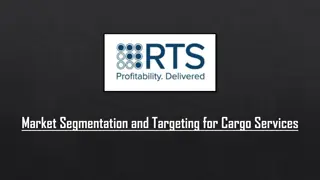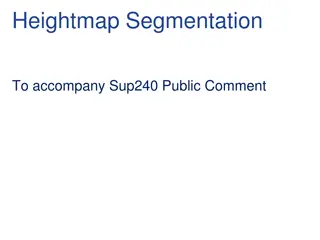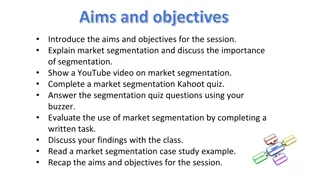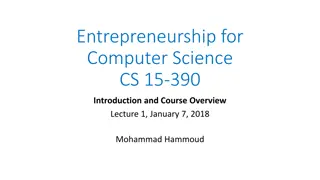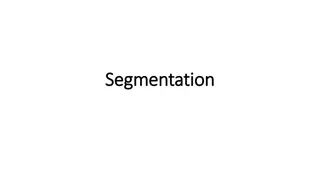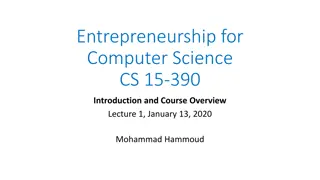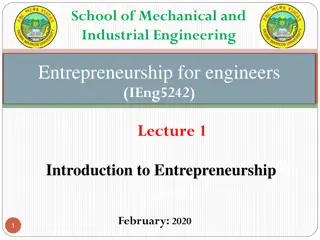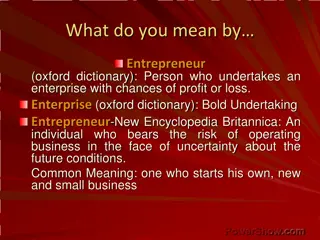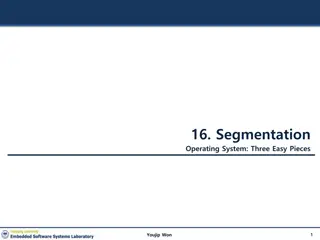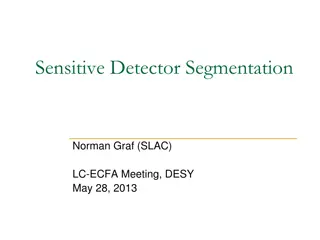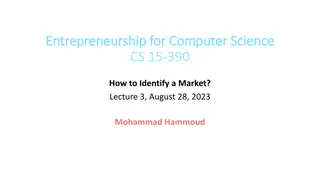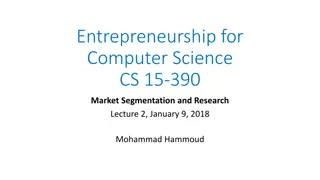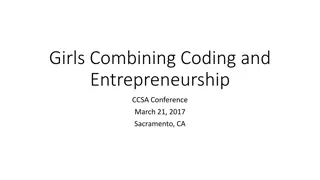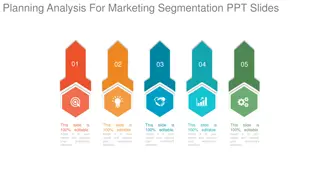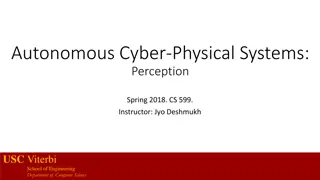Mastering Market Segmentation for Entrepreneurship in Computer Science
Market segmentation is crucial for identifying high-yield market segments in entrepreneurship. This process involves dividing a broad market into sub-groups to tailor strategies effectively. Begin by identifying your passion and a generic idea, then explore industries and end-users within those sectors. By delving into tasks, specialties, and various segmentation methods, you can refine your approach and enhance educational technology initiatives. Starting with a broad perspective and gradually narrowing down can open up new opportunities in startup founding.
Download Presentation

Please find below an Image/Link to download the presentation.
The content on the website is provided AS IS for your information and personal use only. It may not be sold, licensed, or shared on other websites without obtaining consent from the author. Download presentation by click this link. If you encounter any issues during the download, it is possible that the publisher has removed the file from their server.
E N D
Presentation Transcript
Entrepreneurship for Computer Science CS 15-390 Market Segmentation Lecture 6, February 03, 2020 Mohammad Hammoud
Today Last Session: Project presentations Today s Session: Market segmentation Announcement: PS1 grades will be out by tomorrow
Market Segmentation Market segmentation is the process of dividing a broad consumer or business market into sub-groups (or segments) in an aim to identify high yield segments. It may also help you come up with an idea!
The Segmentation Process (1 Way of Doing it) Step 0: Identify your passion E.g., Technology (i.e., expertise) & Education (i.e., domain/market) Step 1: Start with a generic idea E.g., I want to improve education through technology Step 2: Identify potential industries of your selected domain E.g., Universities, schools, centers, etc., Step 3: Identify all end-users in your industries End-users are potential people who will use your potential product E.g., Teachers, Students, Administrators, Parents, etc.,
The Segmentation Process (1 Way of Doing it) Step 3 (Cont d): Identify all end-users in your industries End-users are not necessarily economic buyers E.g., Schools do not use course or advising systems, but teachers do You can follow different segmentation methods (e.g., characteristics of customers, benefits sought, interaction channels, etc.), pursue any logical order and go as deep as you like Step 4: Identify different tasks your end-users perform E.g., Teachers teach, grade, advise, etc., Step 5: Identify different specialties of your end-users ...
Example Improve Education through Technology Generic Idea . Education Centers Universities Schools Industries . End-Users Professors Administrators Students Computer Science . Specialties Sociology Business . Tasks Teaching Grading Advising ...
Market Segmentation Technique: Start somewhere (passion can lead) One of the key things in founding a startup is to start; it is right there in the name! Come up with a generic idea and segment its domain (or market) constituents, following a logical order Open the aperture as wide as possible This helps in expanding the boundaries of possibilities to where some of the most interesting opportunities might exist
Market Segmentation Technique: Identify the sub-tree on the tree that intrigues you the most and try to tap into your expertise to solve a seemingly (i.e., not yet confirmed) pain there No idea is too crazy at this point (and even later)! If you insist and prove it, people will follow
Market Segmentation Technique: Identify the sub-tree on the tree that intrigues you the most and try to tap into your expertise to solve a seemingly (i.e., not yet confirmed) pain there No idea is too crazy at this point (and even later)! If you insist and prove it, people will follow In fact, in the startup world, most good ideas are hidden down deep in the tree and/or seem bad initially. If they were obviously visible and good, someone would have already be doing them! Do not combine segments that seem similar without knowing more about your potential customers Build a market segmentation matrix
Market Segmentation Matrix: Row Definitions Row Row Row Row Row Row Row Definition Definition Definition Definition Definition Definition Definition 1 1 1 1 1 1 1 Market Segment Name Market Segment Name Market Segment Name Market Segment Name Market Segment Name Market Segment Name Market Segment Name This is the market opportunity that you will identify for your product This is the market opportunity that you will identify for your product This is the market opportunity that you will identify for your product This is the market opportunity that you will identify for your product This is the market opportunity that you will identify for your product This is the market opportunity that you will identify for your product This is the market opportunity that you will identify for your product 2 2 2 2 2 2 2 End User End User End User End User End User End User End User This is the person who will use your product and not the economic buyer. Even if you will This is the person who will use your product and not the economic buyer. Even if you will This is the person who will use your product and not the economic buyer. Even if you will This is the person who will use your product and not the economic buyer. Even if you will This is the person who will use your product and not the economic buyer. Even if you will This is the person who will use your product and not the economic buyer. Even if you will This is the person who will use your product and not the economic buyer. Even if you will sell to a company, list here the people who will use your product in that company sell to a company, list here the people who will use your product in that company sell to a company, list here the people who will use your product in that company sell to a company, list here the people who will use your product in that company sell to a company, list here the people who will use your product in that company sell to a company, list here the people who will use your product in that company sell to a company, list here the people who will use your product in that company 3 3 3 3 3 3 3 Task Task Task Task Task Task Task What exactly is it that the end users do that you will significantly affect or allow them to do What exactly is it that the end users do that you will significantly affect or allow them to do What exactly is it that the end users do that you will significantly affect or allow them to do What exactly is it that the end users do that you will significantly affect or allow them to do What exactly is it that the end users do that you will significantly affect or allow them to do What exactly is it that the end users do that you will significantly affect or allow them to do What exactly is it that the end users do that you will significantly affect or allow them to do that they could not do before? that they could not do before? that they could not do before? that they could not do before? that they could not do before? that they could not do before? that they could not do before? 4 4 4 4 4 4 4 Benefit Benefit Benefit Benefit Benefit Benefit Benefit What is the benefit that you believe the end users will get? What is the benefit that you believe the end users will get? What is the benefit that you believe the end users will get? What is the benefit that you believe the end users will get? What is the benefit that you believe the end users will get? What is the benefit that you believe the end users will get? What is the benefit that you believe the end users will get? 5 5 5 5 5 5 5 Urgency of Need Urgency of Need Urgency of Need Urgency of Need Urgency of Need Urgency of Need Urgency of Need What is the level of urgency to solve the problem or capture the new opportunity for the What is the level of urgency to solve the problem or capture the new opportunity for the What is the level of urgency to solve the problem or capture the new opportunity for the What is the level of urgency to solve the problem or capture the new opportunity for the What is the level of urgency to solve the problem or capture the new opportunity for the What is the level of urgency to solve the problem or capture the new opportunity for the What is the level of urgency to solve the problem or capture the new opportunity for the end user? end user? end user? end user? end user? end user? end user? 6 6 6 6 6 6 6 Example End Users Example End Users Example End Users Example End Users Example End Users Example End Users Example End Users Who are examples of end users that you can, have, or will talk to, so as to validate your Who are examples of end users that you can, have, or will talk to, so as to validate your Who are examples of end users that you can, have, or will talk to, so as to validate your Who are examples of end users that you can, have, or will talk to, so as to validate your Who are examples of end users that you can, have, or will talk to, so as to validate your Who are examples of end users that you can, have, or will talk to, so as to validate your Who are examples of end users that you can, have, or will talk to, so as to validate your perceptions of this market segment perceptions of this market segment perceptions of this market segment perceptions of this market segment perceptions of this market segment perceptions of this market segment perceptions of this market segment 7 7 7 7 7 7 7 Lead Customers Lead Customers Lead Customers Lead Customers Lead Customers Lead Customers Lead Customers Who are the influential customers (i.e., lighthouse customers) where, if they buy your Who are the influential customers (i.e., lighthouse customers) where, if they buy your Who are the influential customers (i.e., lighthouse customers) where, if they buy your Who are the influential customers (i.e., lighthouse customers) where, if they buy your Who are the influential customers (i.e., lighthouse customers) where, if they buy your Who are the influential customers (i.e., lighthouse customers) where, if they buy your Who are the influential customers (i.e., lighthouse customers) where, if they buy your product, others will take note and likely follow? product, others will take note and likely follow? product, others will take note and likely follow? product, others will take note and likely follow? product, others will take note and likely follow? product, others will take note and likely follow? product, others will take note and likely follow?
Market Segmentation Matrix: Row Definitions Row Row Row Row Row Row Definition Definition Definition Definition Definition Definition 8 8 8 8 8 8 Willingness to Change Willingness to Change Willingness to Change Willingness to Change Willingness to Change Willingness to Change How conservative is this market segment? How open are they to change? Is there something to force change (e.g., impending crisis)? something to force change (e.g., impending crisis)? something to force change (e.g., impending crisis)? something to force change (e.g., impending crisis)? something to force change (e.g., impending crisis)? something to force change (e.g., impending crisis)? How conservative is this market segment? How open are they to change? Is there How conservative is this market segment? How open are they to change? Is there How conservative is this market segment? How open are they to change? Is there How conservative is this market segment? How open are they to change? Is there How conservative is this market segment? How open are they to change? Is there 9 9 9 9 9 9 Frequency of Buying Frequency of Buying Frequency of Buying Frequency of Buying Frequency of Buying Frequency of Buying How often do they buy new products? What does their buying cycle look like at high level? How often do they buy new products? What does their buying cycle look like at high level? How often do they buy new products? What does their buying cycle look like at high level? How often do they buy new products? What does their buying cycle look like at high level? How often do they buy new products? What does their buying cycle look like at high level? How often do they buy new products? What does their buying cycle look like at high level? 10 10 10 10 10 10 Concentration of Concentration of Concentration of Concentration of Concentration of Concentration of Buyers Buyers Buyers Buyers Buyers Buyers How many different buyers are there in this market segment? Is it a monopoly? Oligopoly How many different buyers are there in this market segment? Is it a monopoly? Oligopoly How many different buyers are there in this market segment? Is it a monopoly? Oligopoly How many different buyers are there in this market segment? Is it a monopoly? Oligopoly How many different buyers are there in this market segment? Is it a monopoly? Oligopoly How many different buyers are there in this market segment? Is it a monopoly? Oligopoly (a small number of buyers)? Or may competitive buyers? (a small number of buyers)? Or may competitive buyers? (a small number of buyers)? Or many competitive buyers? (a small number of buyers)? Or many competitive buyers? (a small number of buyers)? Or many competitive buyers? (a small number of buyers)? Or many competitive buyers? 11 11 11 11 11 11 Other Relative Market Other Relative Market Other Relative Market Other Relative Market Other Relative Market Other Relative Market Considerations Considerations Considerations Considerations Considerations Considerations This allows for customization of your segment for your relevant considerations such as high employee turnover , very low margins/commodity , high-growth industry , high virality effect (i.e., word of mouth), etc. virality effect (i.e., word of mouth), etc. virality effect (i.e., word of mouth), etc. virality effect (i.e., word of mouth), etc. virality effect (i.e., word of mouth), etc. virality effect (i.e., word of mouth), etc. This allows for customization of your segment for your relevant considerations such as This allows for customization of your segment for your relevant considerations such as This allows for customization of your segment for your relevant considerations such as This allows for customization of your segment for your relevant considerations such as This allows for customization of your segment for your relevant considerations such as high employee turnover , very low margins/commodity , high-growth industry , high high employee turnover , very low margins/commodity , high-growth industry , high high employee turnover , very low margins/commodity , high-growth industry , high high employee turnover , very low margins/commodity , high-growth industry , high high employee turnover , very low margins/commodity , high-growth industry , high 12 12 12 12 12 12 Size of Market (# of End Size of Market (# of End Size of Market (# of End Size of Market (# of Size of Market (# of Size of Market (# of End Users) Users) Users) Users) End Users) End Users) Estimation of the number of end users to a relevant range (10s, 100s, 1Ks, 10Ks, 100Ks, 1Ms, etc.). 1Ms, etc.). 1Ms, etc.). 1Ms, etc.). 1Ms, etc.). 1Ms, etc.). Estimation of the number of end users to a relevant range (10s, 100s, 1Ks, 10Ks, 100Ks, Estimation of the number of end users to a relevant range (10s, 100s, 1Ks, 10Ks, 100Ks, Estimation of the number of end users to a relevant range (10s, 100s, 1Ks, 10Ks, 100Ks, Estimation of the number of end users to a relevant range (10s, 100s, 1Ks, 10Ks, 100Ks, Estimation of the number of end users to a relevant range (10s, 100s, 1Ks, 10Ks, 100Ks, 13 13 13 13 13 13 Est. Value of End User ($1, $10, $100, $1K, etc.) etc.) etc.) etc.) etc.) etc.) Est. Value of End User ($1, $10, $100, $1K, ($1, $10, $100, $1K, ($1, $10, $100, $1K, ($1, $10, $100, $1K, ($1, $10, $100, $1K, Est. Value of End User Est. Value of End User Est. Value of End User Est. Value of End User A first-pass estimate of the value of each end user, again to a relevant order of magnitude so you can make some relative decisions now (you will do a deep dive into this and other so you can make some relative decisions now (you will do a deep dive into this and other so you can make some relative decisions now (you will do a deep dive into this and other so you can make some relative decisions now (you will do a deep dive into this and other so you can make some relative decisions now (you will do a deep dive into this and other A first-pass estimate of the value of each end user, again to a relevant order of magnitude so you can make some relative decisions now (you will do a deep dive into this and other numbers later). numbers later). numbers later). numbers later). numbers later). numbers later). A first-pass estimate of the value of each end user, again to a relevant order of magnitude A first-pass estimate of the value of each end user, again to a relevant order of magnitude A first-pass estimate of the value of each end user, again to a relevant order of magnitude A first-pass estimate of the value of each end user, again to a relevant order of magnitude
Market Segmentation Matrix: Row Definitions Row Row Row Row Definition Definition Definition Definition 14 14 14 14 Competition/ Competition/ Competition/ What will be your competition from the end users perspective?Include the do nothing What will be your competition from the end users perspective?Include the do nothing What will be your competition from the end users perspective?Include the do nothing Competition/ Alternatives Alternatives Alternatives Alternatives What will be your competition from the end users perspective?Include the do nothing option as well as who else would be competitors if the end users analyzed their options option as well as who else would be competitors if the end users analyzed their options option as well as who else would be competitors if the end users analyzed their options option as well as who else would be competitors if the end users analyzed their options 15 15 15 15 Other Components Other Components Since most customers will buy a full solution and not an individual component that they Other Components Needed for a Full Solution Solution Solution Solution Since most customers will buy a full solution and not an individual component that they have to assemble into a full solution, what other elements are needed to construct a full have to assemble into a full solution, what other elements are needed to construct a full Since most customers will buy a full solution and not an individual component that they have to assemble into a full solution, what other elements are needed to construct a full solution to achieve the benefits above? These are the complementary assets that you do not currently have but would need to build or acquire to give the end user a full solution not currently have but would need to build or acquire to give the end user a full solution not currently have but would need to build or acquire to give the end user a full solution not currently have but would need to build or acquire to give the end user a full solution Other Components Needed for a Full Needed for a Full Needed for a Full Since most customers will buy a full solution and not an individual component that they have to assemble into a full solution, what other elements are needed to construct a full solution to achieve the benefits above? These are the complementary assets that you do solution to achieve the benefits above? These are the complementary assets that you do solution to achieve the benefits above? These are the complementary assets that you do 16 16 16 16 Important Partners Important Partners Important Partners Important Partners Who are the partners or distributors you will have to work with to fit into the end user s Who are the partners or distributors you will have to work with to fit into the end user s workflow (e.g., data must come out of vendor A s system and then be picked up at the end workflow (e.g., data must come out of vendor A s system and then be picked up at the end Who are the partners or distributors you will have to work with to fit into the end user s workflow (e.g., data must come out of vendor A s system and then be picked up at the end by vendor B s system) or business processes (e.g., the end user gets all his or her product via distribution channel C)? via distribution channel C)? via distribution channel C)? via distribution channel C)? Who are the partners or distributors you will have to work with to fit into the end user s workflow (e.g., data must come out of vendor A s system and then be picked up at the end by vendor B s system) or business processes (e.g., the end user gets all his or her product by vendor B s system) or business processes (e.g., the end user gets all his or her product by vendor B s system) or business processes (e.g., the end user gets all his or her product 17 17 17 17 Other Relevant Other Relevant In many market segmentation analyses, there are additional important factors that should Other Relevant Personal Considerations Considerations Considerations Considerations In many market segmentation analyses, there are additional important factors that should be considered. These could be things like where the market segment is geographically be considered. These could be things like where the market segment is geographically In many market segmentation analyses, there are additional important factors that should be considered. These could be things like where the market segment is geographically centered, whether it matches the values of the founding team, existing knowledge and contacts in market, etc. contacts in market, etc. contacts in market, etc. contacts in market, etc. Other Relevant Personal Personal Personal In many market segmentation analyses, there are additional important factors that should be considered. These could be things like where the market segment is geographically centered, whether it matches the values of the founding team, existing knowledge and centered, whether it matches the values of the founding team, existing knowledge and centered, whether it matches the values of the founding team, existing knowledge and
Market Segmentation Matrix Template Market Segment Name End User Task Benefit Urgency of Need . . . Other Relevant Personal Considerations
Market Segmentation Matrix Template Market Segment Name End User Task Benefit Urgency of Need Populate the cells using effective market research . . . Other Relevant Personal Considerations
Effective Market Research Conducting effective market research is a fundamental skill that underlies the entire process of starting a company Some Characteristics: Multi-dimensional: It spans various (potential) customer dimensions, including rational, emotional, economical, social, and cultural, among others Continuous: It informs every stage in starting and running a company Customers and markets change over time, so what is true one year may be invalid the next
Effective Market Research Some Characteristics: Non-tradable: It is dangerous to outsource market research, especially if it involves direct interactions with (potential) customers Hypothesis Validator: It plays a critical role in validating or invalidating hypotheses quickly, especially before starting product development (as a result, you can spend more time building products that customers want) Hypothesis Generator: It serves in generating new types of hypotheses that can be validated through experiments, especially when done qualitatively
Types of Market Research Type Type Type Type Definition Definition Definition Definition Primary Market Research Primary Market Research Primary Market Research Primary Market Research Involves direct interaction with (potential) customers to understand their situations and gain knowledge specific to your (potential) new venture situations and gain knowledge specific to your (potential) new venture situations and gain knowledge specific to your (potential) new venture situations and gain knowledge specific to your (potential) new venture Involves direct interaction with (potential) customers to understand their Involves direct interaction with (potential) customers to understand their Involves direct interaction with (potential) customers to understand their Secondary Market Research Secondary Market Research Secondary Market Research Secondary Market Research Involves indirect investigations, especially via collecting information from reputable sources other than potential customers (e.g., standard industry reputable sources other than potential customers (e.g., standard industry reputable sources other than potential customers (e.g., standard industry Involves indirect investigations, especially via collecting information from Involves indirect investigations, especially via collecting information from Involves indirect investigations, especially via collecting information from reputable sources other than potential customers (e.g., standard industry and government reports) and government reports) and government reports) and government reports) Qualitative Market Research Qualitative Market Research Qualitative Market Research Qualitative Market Research An exploratory process that helps understanding qualitatively a subject matter, which might lead to new testable hypotheses (can be used in primary matter, which might lead to new testable hypotheses (can be used in primary matter, which might lead to new testable hypotheses (can be used in primary An exploratory process that helps understanding qualitatively a subject matter, which might lead to new testable hypotheses (can be used in primary and secondary types of researches) and secondary types of researches) and secondary types of researches) and secondary types of researches) An exploratory process that helps understanding qualitatively a subject An exploratory process that helps understanding qualitatively a subject Quantitative Market Research Quantitative Market Research Quantitative Market Research Quantitative Market Research Focuses on gathering specific data, which prove or disprove a certain Focuses on gathering specific data, which prove or disprove a certain Focuses on gathering specific data, which prove or disprove a certain Focuses on gathering specific data, which prove or disprove a certain hypothesis hypothesis hypothesis hypothesis
Next Class Conclude with Effective Market Research Discuss How to Select a Beachhead Market




